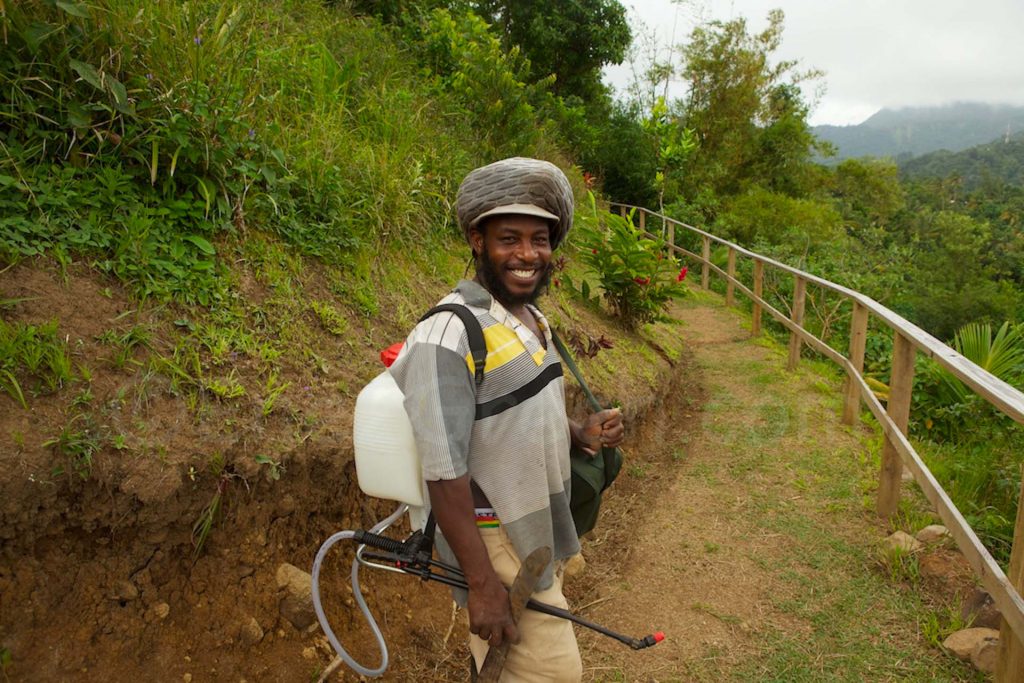A model of ecotourism
The Tet Paul Nature Trail subscribes to a sustainable development approach and represents an excellent example of ecotourism throughout the Caribbean. The inhabitants of the Chateau Belair agricultural area were first consulted in the design phase of the project, and were later involved at all stages of development and implementation. The guides and agricultural workers have been recruited within the community and have been trained to welcome visitors and maintain the site.
We can therefore assert today that the Tet Paul Nature Trail is an ecotourism product that is 100% designed and managed locally.
Creole gardens, places that are respectful of people and the environment
The first Creole gardens were created on lands close to slave huts in the days of slavery. After the abolition of slavery in Saint Lucia in 1833, emancipated slaves continued the tradition of ‘negro gardens’ around their huts. Creole gardens still exist today and are the descendants of the gardens of emancipated slaves.
These subsistence gardens not only ensure the family’s food self-sufficiency, but also create a complementary income. Two farmers from the community work on the Tet Paul Nature Trail plot and the vegetables, fruit and plants grown there are distributed among their families and the Chateau Belair community.
Creole gardens are governed by a number of principles and specific traditional techniques are used. These gardens are respectful of people and the environment, and deserve to regain the place that they formerly held in the daily life of Caribbean people.
Traditional cultivation techniques free of fertilisers and pesticides
Creole gardens are cultivated manually on small pieces of land. Once ploughed, these gardens do not need to be set aside as traditional cultivation techniques often take cycles into account. The addition of fertilisers or pesticides is not required.
Food crops include okra, yam, bananas, sugarcane, cocoyam leaves, sweet potatoes, peas, pineapples, West Indian gherkins, Maracuya (passion fruit) as well as tomatoes, eggplant, lettuce, beans, carrots and turnips.
The orchards generally comprise mango, coconut, breadfruit, avocado, papaya, lemon, calabash, soursop, guava, West Indian cherry and ambarella trees.
In addition, the most basic aromatic and medicinal plants are cultivated – including aromatic plants such as country onion (or leek), chilli, thyme, basil, mint, ginger and parsley as well as plants like goat weed, billygoat weed, tilo, vervain, lantana, Starchytarpheta jamaicensis, aloe and lemongrass.
Promoting the traditional way of life
The Creole gardens and the huts are closely linked. As a whole, they operate like a stand-alone system. The visit of a traditional hut is part of the thematic path and thus allows visitors to imagine the way of life of emancipated slaves after the abolition of slavery.
Creole huts were made of wood and consisted in a simple main room as well as two or three side rooms which were used as bedrooms. The floor of the hut was made of dirt or wood, depending if the household could afford it.
The house generally faced east, where the sun rises. This allowed keeping the house sunny. Awnings provided protection for sunny or rainy weather.
The huts located in elevated regions have a low ceiling to warm up the ceiling, and inversely, those in lower-lying areas have a ceiling at about 6 m high to allow ventilation of the house and avoid shaking caused by the wind.
The windows open on the outside and have wooden shutters for protection from bad weather. They allow the air to circulate and provide natural cooling inside the dwelling.
The construction of huts was a social act of particular importance in the life of the farming community, and was often accompanied by certain specific rites.
Breathtaking views
In addition to its botanic and historic centres, the path offers the most spectacular views on the island.
Beside the first observation point, beyond an incredible palette of green that mixes with blue, there is a view of the south of the island including the Vieux-Fort, Choiseul and Maria Island as well as Mount Gimie. Smoke rises here and there above the ground vegetation, like witnesses of the nearby communities and we can hear reggae music, which immerses us in a most pleasant atmosphere.
The last point is the highlight of the visit, offering breathtaking views of Jalousie Bay and the Soufrière Pitons lined with emerald-blue waters. We were not able to see the tip of the cones, which suddenly disappeared during the walk in a waft of mist, adding a touch of mystery to the landscape.
After a photo session, we take the remarkably fitted out wooden staircase and leave with regret this absolutely magnificent and spellbinding place with a sense of tropical serenity.



